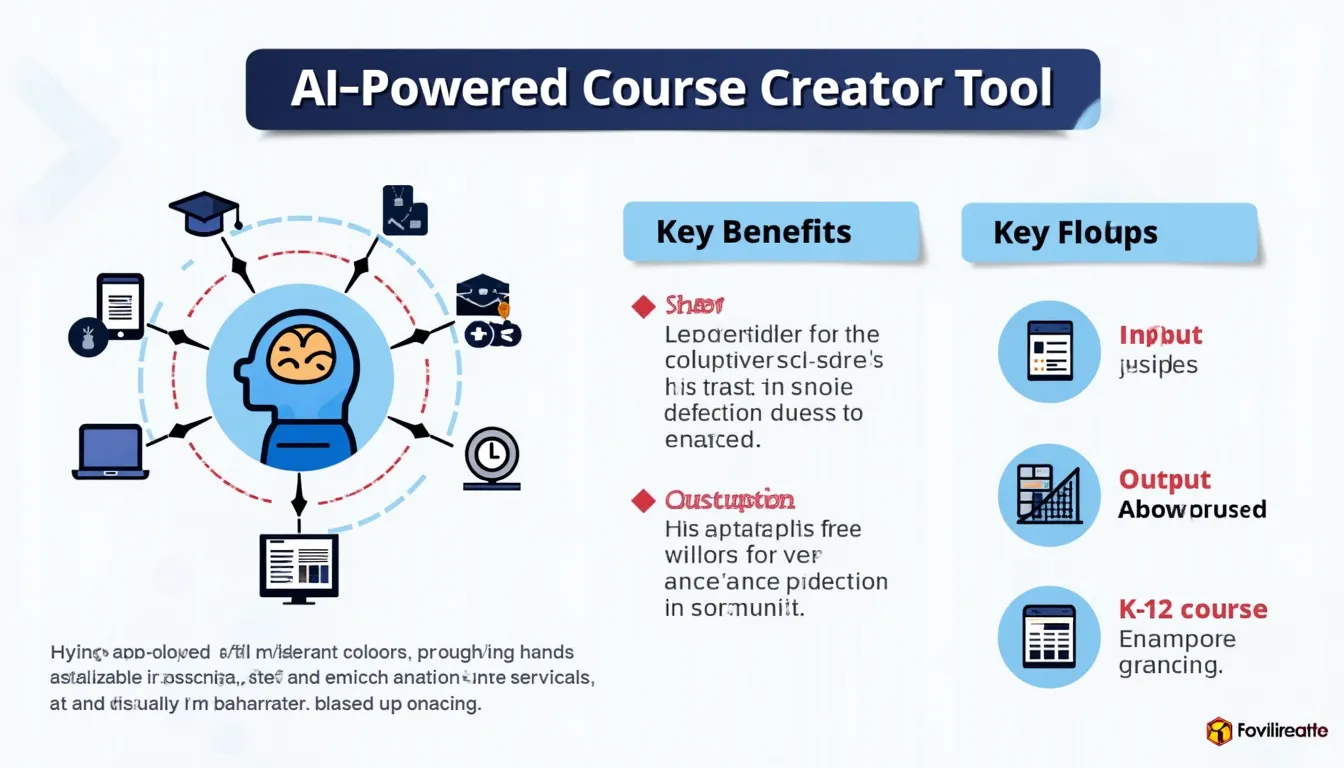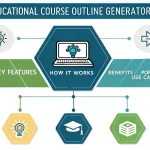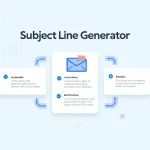Is this tool helpful?
How to Use the Course Outline Generator Tool Effectively
The Course Outline Generator is designed to simplify the curriculum planning process by providing educators and instructional designers with a quick way to create detailed course structures. To make the most of this powerful course creation tool, follow these straightforward steps:
- Input the Course Title: Enter the name of the course you want to develop. For example, “Fundamentals of Cybersecurity” or “Creative Photography Techniques”.
- Specify the Intended Learners: Describe the target audience for your course. This might be “Working professionals in IT security” or “Amateur photographers interested in portraiture”.
- Set Course Duration: Provide the total length of the course in weeks. Examples include “8” for a short workshop or “16” for a semester-long course.
- Click the Generate Button: Once all fields are complete, select the “Generate Course Outline” button to quickly produce a well-structured curriculum plan.
- Review the Generated Outline: The tool will create a comprehensive course framework including modules, learning objectives, and suggested assessments, which you can customize as needed.
- Copy and Save Your Outline: Use the copy function to easily save the generated content for further editing or integration into your syllabus or course management platform.
Introducing the Course Outline Generator: Definition, Purpose, and Key Benefits
What is the Course Outline Generator?
The Course Outline Generator is an AI-powered educational planning assistant designed to transform simple course details into an extensive, carefully organized curriculum plan. By leveraging advanced artificial intelligence, it helps educators develop complete course structures with clear learning objectives, logical sequencing, and relevant assessment suggestions — all within minutes.
Purpose and Core Functionality
This intelligent tool aims to automate the early stages of curriculum design, enabling educators to spend more time fine-tuning content and facilitating learning rather than building frameworks from scratch. Key features include:
- Generating a coherent module breakdown aligned with course duration and subject matter
- Crafting specific learning objectives customized to the target audience
- Recommending suitable assessment techniques and interactive learning activities
- Offering a structured blueprint to support syllabus creation and resource planning
Benefits of Using AI to Create Course Outlines
Integrating AI into course design offers significant advantages that improve both efficiency and quality, including:
- Accelerated Course Planning: Quickly generates the foundational course structure, saving hours of manual planning.
- Consistent Curriculum Quality: Ensures uniform design principles across multiple courses or programs.
- Pedagogically Sound: Creates learning objectives and assessments based on established educational frameworks like Bloom’s Taxonomy.
- Customization for Audience Needs: Tailors content and difficulty according to the specified learner profile and course length.
- Comprehensive Coverage: Includes suggestions for interactive elements, assessments, and resource integration to enhance learner engagement and success.
Practical Applications of the Course Outline Generator Tool
Accelerate Curriculum Development for Various Educational Settings
This tool is versatile and can be applied across multiple education domains including universities, corporate training, and K-12 programs. Here’s how it supports practical course creation:
University-Level Curriculum Design
- Develop semester-long course plans with structured modules and clear learning goals.
- Integrate hands-on projects and research assignments aligned with academic standards.
- Ensure courses stay current by quickly modifying outlines for emerging topics.
Corporate Training Program Development
- Create targeted upskilling programs for professionals with flexible durations.
- Incorporate interactive elements such as role-playing and simulations to boost engagement.
- Standardize assessments to evaluate real-world application of skills.
K-12 Educational Enhancement
- Design interdisciplinary STEM courses with balanced content across topics.
- Suggest hands-on projects and community resources to enrich learning experiences.
- Adapt course depth and complexity for age-appropriate learning.
Example Calculation for Module Distribution
One key feature of the Course Outline Generator is its ability to optimize the number of course modules based on duration. The formula used to determine modules is:
$$M = \frac{D}{W}$$Where:
- M = Number of modules
- D = Total course duration in weeks
- W = Average weeks assigned per module (commonly 1 or 2 weeks)
For example, a 14-week course with an average of 2 weeks per module would yield:
$$M = \frac{14}{2} = 7$$This means the generated outline would consist of 7 well-defined modules, each covering a focused part of the curriculum.
Unlocking the Full Potential of AI-Powered Course Planning
By using the Course Outline Generator, educators save valuable time while ensuring their courses are pedagogically rigorous and learner-centered. Whether you’re designing a new syllabus from scratch or updating an existing curriculum, this tool offers a streamlined, intelligent approach to crafting educational programs that align with your goals and audience needs.
Key takeaway: Embrace this AI-driven course creator to turn your course ideas into comprehensive, engaging curriculum plans faster than ever before.
Important Disclaimer
The calculations, results, and content provided by our tools are not guaranteed to be accurate, complete, or reliable. Users are responsible for verifying and interpreting the results. Our content and tools may contain errors, biases, or inconsistencies. We reserve the right to save inputs and outputs from our tools for the purposes of error debugging, bias identification, and performance improvement. External companies providing AI models used in our tools may also save and process data in accordance with their own policies. By using our tools, you consent to this data collection and processing. We reserve the right to limit the usage of our tools based on current usability factors. By using our tools, you acknowledge that you have read, understood, and agreed to this disclaimer. You accept the inherent risks and limitations associated with the use of our tools and services.







